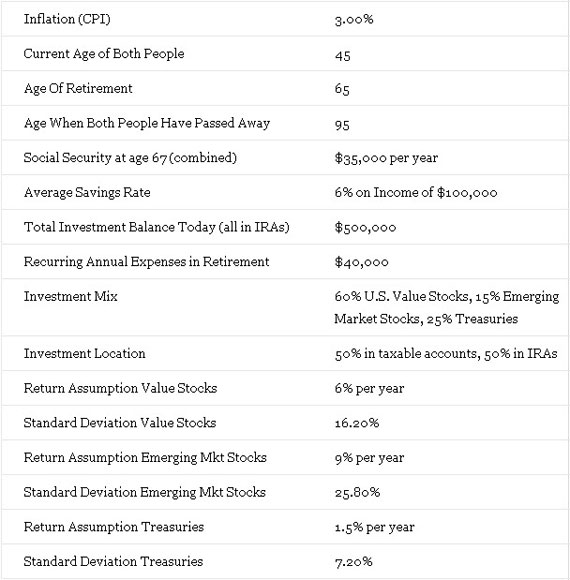With a new year upon us, and with income taxes, capital gains taxes, and dividend taxes going way up for those making over $400,000 per year ($450,000 for joint filers), and payroll taxes going up for everybody else, it’s time once again to ask how much the typical couple might need to retire.

I want to look at a sample couple’s probability of never running out of money in retirement using Monte Carlo analysis, a statistical method that approximates the probability of an outcome -- in this case, never running out of money -- by running multiple simulations on investment returns. The simulations of investment returns are generated using an average return assumption for each investment, the historical volatility (standard deviation) of returns for each investment, and historical correlations among the investment asset classes.
Using these variables along with a random number generator, the investment returns are changed each year in every simulation. We then take the number of simulations where funds never run out divided by the total number of Monte Carlo simulations generated. This gives us the probability that funds are never depleted.
Let’s take a look at how this works. I ran a couple’s retirement plan in our retirement planning application. Here were my starting assumptions:

In the static case, I found that this couple would not run out of money before the end of their plan at age 95. In fact, they would have nearly $500,000 (in today’s dollars) left in their plan when they’re 95. However, this is a static look at things where we assume the total returns of their investments do not change from year to year. Using Monte Carlo analysis, we can input different returns from year to year to account for potential changes in market conditions and calculate the probability of their funds never depleting.
It turns out that in this case the probability that they never run out of money is only 50%. There are just too many scenarios where the total returns are bad enough to deplete their funds. Part of the problem is the volatility of equities today. The other problem is that this couple is not beating inflation with their treasury investments.
Remember that 25% of this couple’s portfolio is invested in Treasuries earning a return well below the rate of inflation. As I pointed out recently here, inflation can simply ruin a portfolio’s value over time. It is incredibly important to at least break even with inflation. So I moved the 25% of Treasury funds they own into a 50/50 combination of Treasury-Inflation Protected Securities (TIPs) and a portfolio of solid dividend paying stocks with a history of consistent dividend growth, such as Johnson & Johnson (NYSE:JNJ), Procter & Gamble (NYSE:PG), Coca-Cola (NYSE:KO), Exxon (NYSE:XOM), Intel (NASDAQ:INTC), and Wal-Mart (NYSE:WMT).
I assumed no increase in the prices of these dividend payers, but I did assume they would continue to increase their dividends at their five-year growth rate. I also assumed that the dividend payers have a lower volatility than typical US stocks, which is generally true given their steadier returns over time due to dividend payments. I assumed a standard deviation of 12% for them. Here is what I found:

The probability of never running out of money increased by a sizable 15%. From here this couple can tweak their plan further by saving more money or retiring later to increase the probability to an even safer number. As an example, if they push out their age of retirement to 67, they would increase the probability that they never run out of money to 75%.
Now let’s take the scenario I just highlighted. The probability of success for the couple in this scenario is 75%. But what if the government decides to change the dividends and capital gains tax rates for everybody? What if the new 20% rate is eventually applied to all tax brackets?
I ran this scenario and found that the probability of them never running out of money drops to 68%. It’s not catastrophic, but it does put a dent in their ability to feel comfortable about their retirement situation.
Of course, there is also the question of Social Security benefits and whether any of us will receive what was promised. Let’s say that we believe Social Security payments will be cut by 10% for this couple. What does that do to their probability of success? It drops it to 59%. Needless to say, assumptions about Social Security in the future play a large role in most people’s retirement plans.
We live in a world of change and nothing is static. Building a retirement plan is fraught with assumptions, even those that use Monte Carlo analysis. But we can give ourselves a more realistic look at how things might pan out if we use statistical tools and run plenty of what-if scenarios to see how our retirement might pan out when things change.
This article by Douglas Carey originally appeared on Minyanville.
More from Minyanville:
AIG: The Top 5 Moments of Mind-Melting Chutzpah
5 Ways Microsoft Can Get Back on Track in 2013
For Now, Think Carefully Before Buying Gold




